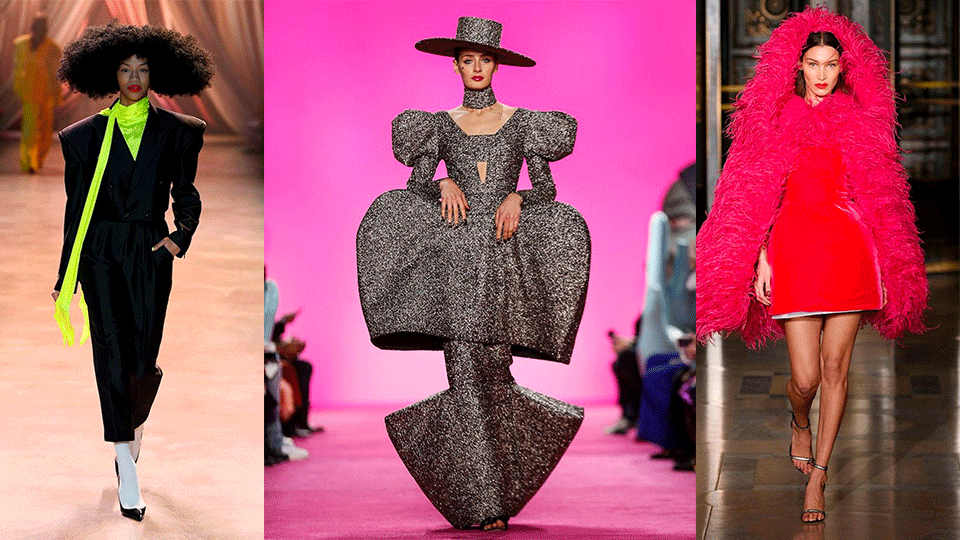- À New Wave to Fashion, À New Way of Living. Download Now on iOS Android Canada SS22
- hello@alahausse.ca
Shifts in the Fashion Industry and Joining the Wave of Sustainable Style

How Digital Eco-Labels On Our Clothes Could Transform The Way We Shop
January 10, 2023
The Basics and Statistics Behind Textile Recycling
January 10, 2023
Written by: Samantha Hamann
Trends in fashion are ever-changing concepts. From pillbox hats in the 1960s to bucket hats in the 2010s and from togas, to tiaras, to Tencel. Trends can change on a dime or a decade, but they always change. However, style changes have gotten much quicker in the last twenty years, with new collections of articles being released on a monthly basis (at the least) and with some retailers having new pieces every week. This rapidly changing release of styles as a market strategy is often referred to as ‘Fast Fashion’ to both fit the pacing and the often subpar quality of the items produced.
Fast fashion is a relatively recent concept, but the market behind it has grown exponentially. The average net worth of a fast-fashion corporation comes in around the high millions and low billions CAD. Fashion Nova alone brings in 1 billion USD annually (~1.3 billion CAD) of sales on its site (source: Forbes). The UK-based retailer ASOS is worth 1.1 billion pounds (1.7 billion CAD) as of 2021 (source: Statista). With numbers like these, it is no surprise that the production of fast fashion articles and the creation of companies have significantly expanded.

Fast vs. Slow Fashion
On the other side of the spectrum from fast fashion is slow fashion. Slow fashion is typically built upon timeless pieces made to last longer in a closet. These articles can also be made from materials with a smaller carbon footprint. As well, slow fashion can reference the reuse of clothes and secondhand shopping. These pieces produced are (often) made to last much longer in a closet because of their quality and their timeless look. Timeless or ‘capsule’ pieces are staple pieces such as a thick winter coat or well-fitted trousers. Staple pieces are available at most retailers (fast or slow), but the resources used within production and how durable the article is depends upon the production processes behind the scenes of the storefront or site.
Resource extraction and utilization are at the beginning of all forms of production. This is one of the first places where sustainable fashion movements connected to slow fashion and (most of) the fast fashion industry differ.
Production Methods
At the core of the sustainability movement is lessening the impact processes, and byproducts of production have on the environment and the ecosystems, biodiversity, and biotic and abiotic organisms within it. This means using materials not overly resource-intensive in their growth process or perhaps reusing old materials to create new products. For example, organic cotton uses significantly less water than other types of cotton, while recycled cotton uses little to no water because it is already created (Sources: Wama Underwear and Gabriel Farias Iribarren). However, recycled cotton is often combined with other fibres to increase the quality of the final product, as the recycling process can weaken the material.
Both eco-based and fast fashion brands have products created using less resource-intensive and/or recycled materials. The difference between a fast fashion or a sustainability-based company often lies in the industry norms they uphold and their corporate social responsibility actions and goals. For an example of industry norms, we can look at how a fast-fashion company’s business practices and models are often built upon the continuous creation of new garments, which are not always crafted to last longer than a few wears without mending. This quick turnaround of articles is where the ‘fast’ in fast fashion comes from. While the move to using sustainable materials is a good start, the problem ultimately lies in how the marketing strategies and production streams are structured.


Corporate Social Responsibility
Corporate Social Responsibility measures a business’s social, environmental, philanthropic, and ethical impacts within its community. These impacts can also affect organizational stakeholders, including workers, consumers, investors, and anyone else affected by the company’s actions, including the greater global community. It is an idea within business studies and other research disciplines based on the notion of corporations and other organizations trying to positively impact the communities they are situated within. For an example of this within a clothing company, we can look to Levi’s and the various ecological and ethical-based initiatives they have implemented to try to make their business better for the community and the planet.
In the search for more sustainable brands and companies, an organization’s transparency about its practices and production has become a significant element. But how can you tell the action behind a statement?
Joining the Sustainable Wave
Fact-checking the ethics and sustainability behind a brand can feel tedious and lead to multiple rabbit holes of information or potentially misinformation. Luckily, quite a few sites do most of the work for you regarding brand background.
Two prominent examples of sites that backcheck a brand and business’s sustainability are B Corporation and Good on You. B Lab and its ‘B Corporation’ site gather impact reports for particular brands and businesses and give comprehensive ratings correlated to their scale of ethics, sustainability, and verifiable action. Good on You is a mobile app and website with the same concept of impact reports and ratings specifically for fashion brands and businesses while also having articles connected to sustainable fashion news and tips. For either of these resources, users can filter by the company’s name. The lists on these sites are not extensive, but they are a good start for what to look for when researching brands and businesses on your own. As an individual consumer, the elements you look for in a brand and how to measure its sustainability and ethics will ultimately be up to personal discretion. Typically, you can start by looking for:
1. Transparency within the production process and ethical worker treatment
2. Related certifications and partnerships such as Fair Trade and Cruelty-Free
3. Carbon neutrality goals and/or implemented offsets
4. If the brand uses recycled materials and how they, and other materials used within production, are sourced
5. Other correlated sustainability, ethics, and community impact and involvement factors such as using vegan materials, fair worker wage, and so on.


Greenwashing
With the rising need to switch to sustainable practices, many companies are campaigning and marketing their products and brand as ‘going green’ and emphasizing new eco-collections. These campaigns can be based upon a fundamental shift within the company in which there is a change connected to the messaging, or it can be a marketing ploy to play to a perceived change in customer views. Marketing lasting a short period or only showing up around a particular time (say, in April for Earth month or earth day) can be a sign of the company not having a change in their processes and production to align with sustainability measures and goals. On the other hand, if the ‘eco-collection’ becomes a regular part of the company, it is best to further look into the production of these articles and the sourcing of their materials. But what does all this mean?
A connection between ‘green’ campaigns and a measurable and verified change in the company towards sustainable practices means the company is not greenwashing because there is an effort behind the marketing. However, if there is no change within the company, a sustainability-based campaign (ongoing or short-term) to market their business, brand, or products would be considered greenwashing (source: Earth.Org).
Why Join the Wave?
As consumers, our choices can affect the way companies operate and how the communities connected to them are affected. When we show support for specific causes such as sustainability by opting for products that last longer in style and quality and are created with ethically sourced and planet-friendly materials, it can prompt significant change within organizations and the greater global community. This change then positively affects the planet and its people.

À New Wave to Fashion. À New Way of Living.
Your First and Last Sustainable AI and Social Powered P2P/B2C Multifunctional Ecosystem (BUY/SELL/RENT/LEND/ SWAP/GIFT), for Me and You.
Apple: https://apple.co/3F8EgcJ
Android: https://bit.ly/3f7jEY3
Via ÀLA.HAUSSE’s Multi-functional and Multi-purposeful Fashion Ecosystem- BUY/SELL/RENT/LEND mobile application, INDIVIDUALS & brands ( BETA) are encouraged to REBUY, RESELL, REUSE and UP-CYCLE their personal “Clossets” aka Clothing Assets. Through this consumerism habit shift we slow down the urgency on fashion carbon footprint, aiding sustainability as a whole.
Launching NOW on iOS Android Canada
Give me a read: shorturl.at/rIMT8
More stories on www.alahausse.ca, Medium & Hackernoon. Follow & Tag @ala.hausse
#ALAHAUSSE #WEARYOURPURPOSE #HAUSSEPEOPLE
References:
- 7 Rs for Sustainable Fashion – Treehugger
- Your clothes can have an afterlife: Strategies for greater reuse and recycling of textiles – National Institute of Standards and Technology
- Redefining ‘Sustainable Fashion’ – The New York Times
- Why Is The Slow Fashion Movement Important? – Eluxe Magazine
- What Fashion Can Do About Sustainability: Four Ways To Cut Back And Move Forward – Forbes
- Nicholas Kirkwood Says Fashion Needs ‘Radical’ Eco Design ‘Rethink’ – Women’s Wear Daily
- The case for circular fashion: Why retail needs an urgent reckoning – FastCompany
- How Canadian clothing entrepreneurs are disrupting ‘fast fashion’ – CBC News
- Going vintage: The sustainable alternative to fast fashion – Buzz.ie
- The push for more sustainable clothing – AFR
- The Sustainable Fashion Forum Conference 2022 Taught Us These 3 Lessons – Teen Vogue
- Organic Cotton vs Cotton: What’s the Difference? – Wama Underwear
- Organic Cotton vs. Recycled Cotton – Gabriel Farias Iribarren
- The fashion world’s future impact on the planet – The CEO Magazine
- 3 Ways How Fashion Brands Can Move Towards a Sustainable and Net-Zero Future – Fashion United UK
- Style check: How sustainable is the sustainable business for designers in today’s fast fashion? – Firstpost
- What is corporate social responsibility (CSR)? – BDC
- Corporate Social Responsibility (CSR) – Corporate Finance Institute
- What Is Corporate Social Responsibility (CSR)? – The Balance
- Are Levi’s Fast Fashion? An Analysis Of Your Favourite Jeans Ethical Practices – techfashionista
- How to know if a brand is sustainable or not? – OurGoodBrands








